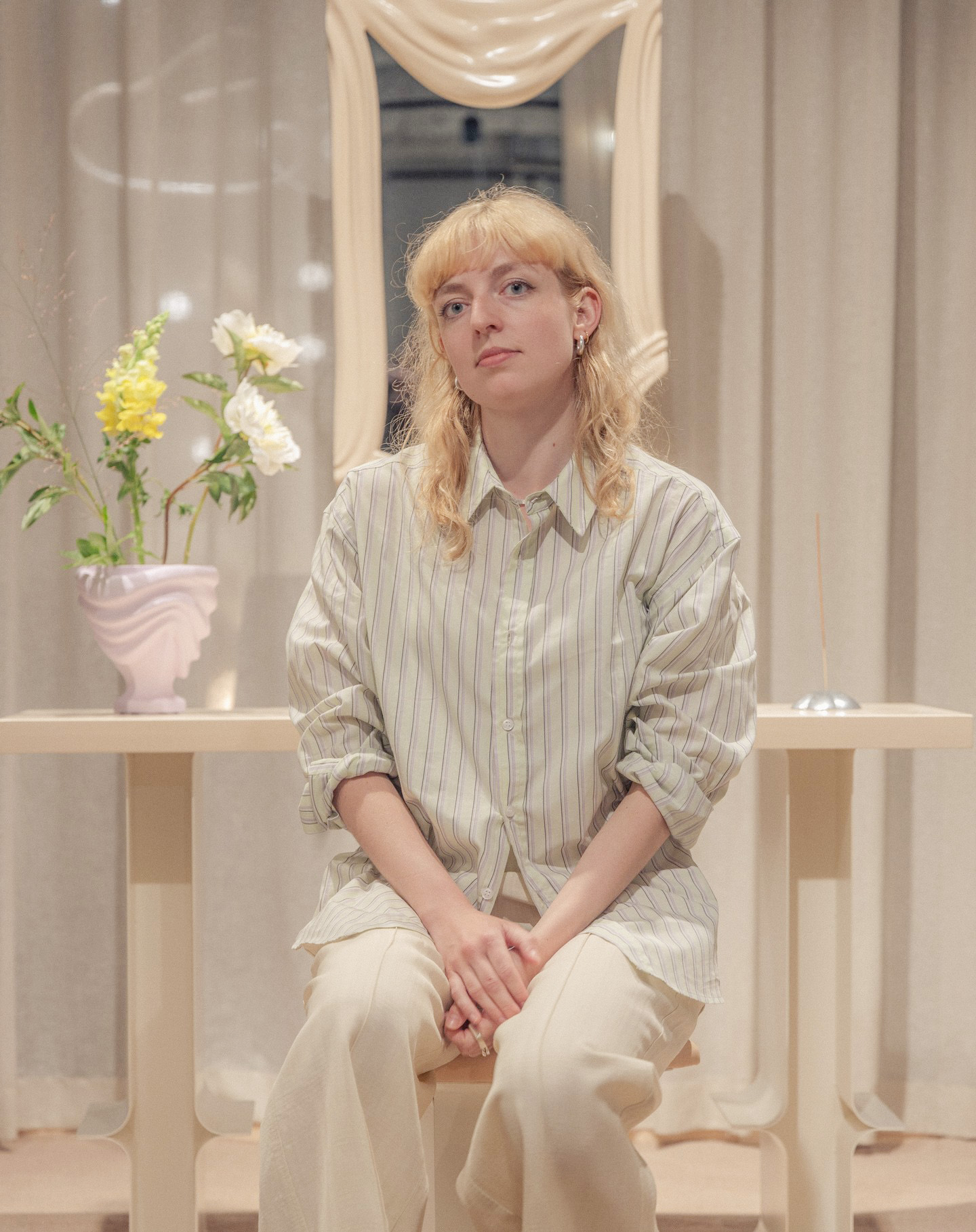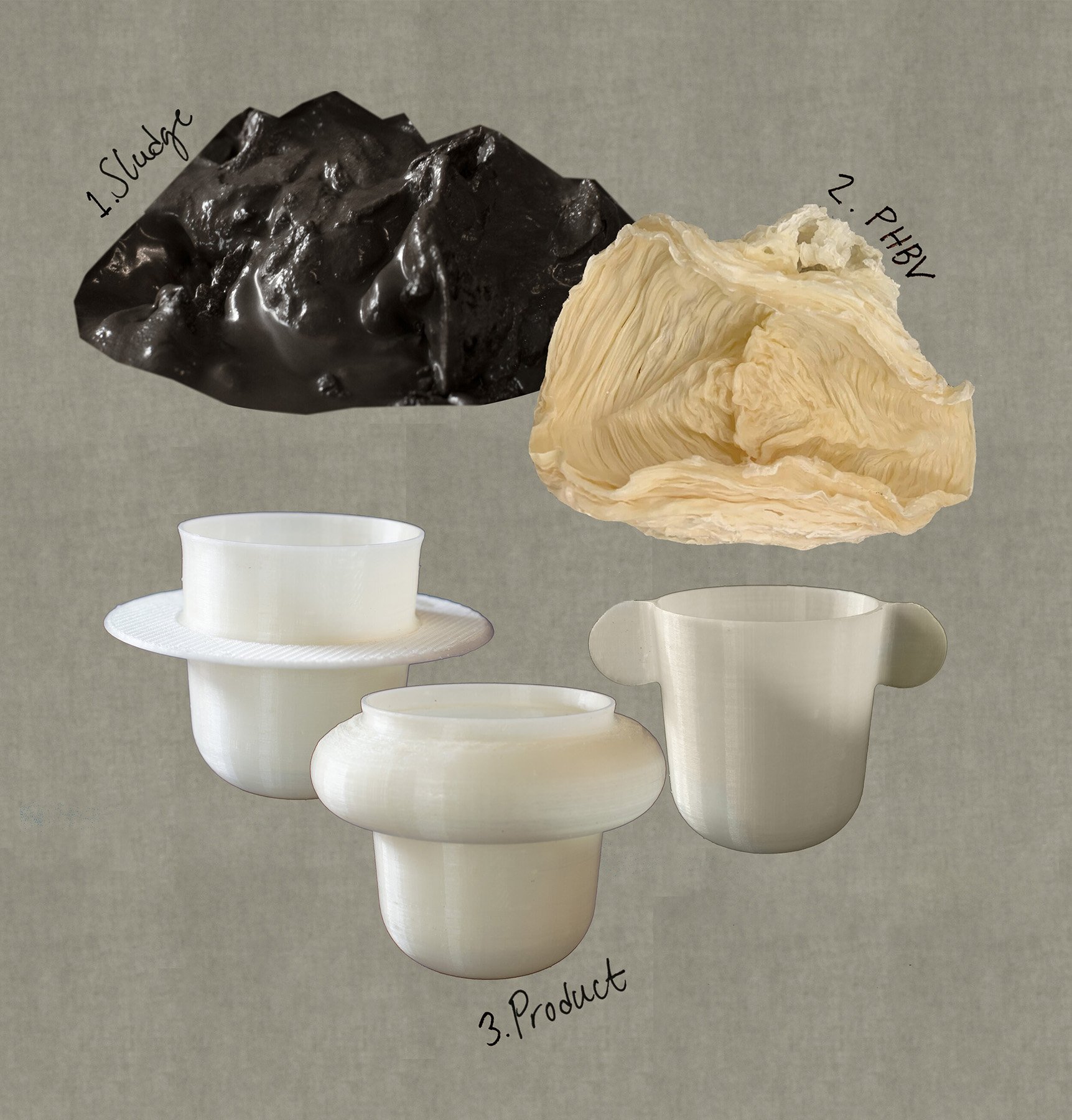Swedish multi-disciplinary artist Ebba Lindgren wants you to know that she’s open for business. She’s always on the look out for collaborators, from individual artists and designers to brands; it’s what is making her tick at the moment. “Though being alone and immersed in the creative process is a basic need for me, it also bores me if I don’t get a break from it. I like collaborations that feel meaningful,” she explains.
Ebba mostly works in the design industry, producing furniture and objects independently, and has recently also started producing some products for larger brands. Her exhibition during Southern Sweden Design Days in May of 2024 called “Alter Ego” was created in collaboration with beloved Swedish furniture brand Källemo, and displayed at Nordiska Galleriet. For this exhibition, she used 3D printing and AI, technological elements she often explores as part of her process.
We sat down with Ebba Lindgren to find out more about her creative process, her innovative work with AI, and her latest exhibition:

Portrait of Ebba Lindgren; Photo credit: Robert Våhlström
What has led you to the place you are in today?
I devote most of my days to my own creative practice. I share a studio with some friends; it’s in the building next to my apartment, so I’m there all the time. Lately, my work and life have become really intertwined. I like it.
It took some time for me understand what I truly wanted from my career.
I was just 19 when I started design school, and I had these fantasies about what adult life and work would be like. I imagined working for a cool industrial design company, earning a large salary and then go home to my boyfriend and forget about it all. Nothing spectacular, but nice and safe. I never really though about running my own business.
When I started working, I realized that this fantasy didn’t make sense. It was hard for me to only work for others, and I really missed the creative freedom from my studies. I was also very disappointed with the design industry’s commercialism, unmindful mass production, shameless copying, and immature status obsession. I have high standards for what “good design” is, and I felt that I wasn’t even close to meeting them myself. The job didn’t do it for me, and I neither had the funds nor maturity to do it on my own.


For a while, I was quite stressed and confused about this, and then 2020 came around and put a pandemic on top of it all. I had a bit of a breakdown, which forced me to reconsider my work and my doubts about going solo.
I slowly started to work towards an independent career. I accepted my artistic side and tried to adjust my life accordingly. I started making my own projects and exploring what I was truly interested in.
I got an art grant, I got a mentor, I got a workshop, and I got an architect boyfriend. Now I’m getting close to finally meeting my own standards. I’m not an exceptional artist yet, but I strive to be.
You have a background in industrial design. How does that inform your design practice today?
It informs my design practice a lot! I think my natural talent lies in the philosophical and intellectual stages of a creative process. I dream up very interesting things, but I wasn’t naturally logical.
Industrial design has made me practical. It has given me the knowledge and confidence to start with a dream-like and fuzzy idea and somehow make it into something real. It has made me appreciate functionality.
I recommend studying industrial design to anyone considering being an artist. It gives you skills! I know how to build things and how to make technical drawings. I know how to run a business. If I had studied art and only catered to my softer, poetic needs, I wouldn’t be equally prepared for the work ahead. I actually think I might have given up art as a career. The framework of industrial design has enabled artistic exploration for me.


Your design is quite conceptual. Take us through the process of concept to execution with a piece or exhibition.
I really enjoy conceptual work. Towards the end of the pandemic, I had grown really fascinated by all the lifestyle brands and bloggers on social media. I was intrigued by the faux personal posts they published. Because the end goal was to sell, right? I had also been in the online dating loop during this time, and I felt the same way about this—it was all about packaging a persona and selling it to a potential partner.
I had a fixation on authenticity and decided to make an experiment where I created a “true lifestyle brand.” I felt like that idea was so strong that I simply had to do it: I was going to empty my apartment, build a workshop in my living room, then design and build all interiors myself. When it was done, I was going to open my home to the public and sell everything.
Because what is more “lifestyle” than buying the bed that the designer herself designed, built, and also slept in? I did it. I called the project “Scenes From a Home.”


Other projects don’t have an obvious beginning. I have had an interest in artificial intelligence for a while now and have naturally integrated that into my projects. It became an important topic in the project “Alter Ego” that I made for Nordiska Galleriet and Källemo. More practically, making many sketches, mockups, and 3D models are important tools in my process, as is working closely with skilled producers and craftspeople.
What are the feelings or emotions you explore and express in your work? Are there certain feelings that you keep coming back to?
I keep coming back to things that bother me, like design as status objects. But even more interesting is working towards coexistence of certain dualities, like artificiality and authenticity, technology and poetry, perfectionism and play.
Sometimes my aesthetics are raw and vivid, and sometimes more sophisticated; it depends on my mood, but they always have some sort of sensuality in the materials or the ways they are presented. I want people to be drawn to my work. I want it to be irresistible to touch.


You recently had an exhibition, “Alter Ego,” at Nordiska Galleriet with Källemo during SouthernSweden Design Days. Can you share a few words about the exhibition?
Yes! The Swedish furniture brand Källemo asked me last year if I wanted to design something for them to exhibit during Southern Sweden Design Days. I already had this idea that I wanted to explore an aesthetic that was new to me: a sacral, unreal aesthetic where I incorporated AI in the design process. Källemo is something of a cult company on the Swedish furniture scene, iconic almost, so this holy theme made a lot of sense.
Källemo gave me complete freedom, which was amazing, but I also felt like I had a lot to live up to.
That’s how the idea of the “Alter Ego” came to be, to help me deal with overwhelming feelings and to allow me to play and experiment. This alter ego is me, but it’s exaggerated. She is:
Artificial where I’m real.
Sacral where I’m banal.
Metal where I’m textile.
Action where I’m intellect.
Resolute where I compromise.
I let these five things lead me in the process. I designed the objects, and Källemo produced them for me. During the process, I kept the conversation around the project, the theme, and the objects going with them.


I designed a mirror that looks like soft textile but is made of a hard material. I designed a table and a stool made from bent metal, lacquered MDF, and soft leather upholstery. I made an over-dimensioned metal and MDF pedestal. I arranged these things in an altar-like fashion, with the mirror hanging from almost invisible wires. I designed a vase and an incense holder to put on the table. Everything was lacquered in similar beige tones to add to the unreal feeling. I framed the room with real textile curtains, warm light, and sand on the floor.
What is it like working during Southern Sweden Design Days? What does this festival bring to the Malmö, and Swedish, design scenes?
It brings a sense of community! There are many of us working on different, but similar, things in the area.
Though I think it would be great to involve more international designers as well, to open up for new collaborations, and to show that southern Sweden is a place where a lot of good things are happening.

Find out more about Ebba Lindgren’s work and Southern Sweden Design Days.

